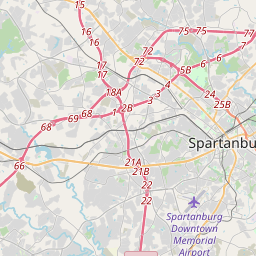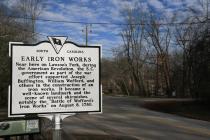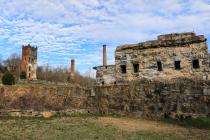Glendale Shoals
— Nature Preserve · Greenway · Paddling Trail · Goodall Environmental Studies Center —
Glendale is a place where history lives. Within a mile of this spot are the sites of a colonial ironworks, a Revolutionary War skirmish, and one of the most historic textile mills in the South. Today, the village still remains, but the mill is gone, destroyed by a fire in 2004. Glendale lives on as a small community with a proud past, quickly changing present, and exciting future.The 30-acre Glendale Shoals Preserve is a partnership between the Spartanburg Area Conservancy (SPACE), Palmetto Conservation Foundation (PCF), and Wofford College.
In 1993, the Spartanburg Area Conservancy received a gift of 13 acres from Billy Tobias and created the Glendale Shoals Preserve. Today this area, across the river, offers picnic tables, nature trails, and access to Lawson's Fork.
In 2004, the Palmetto Conservation Foundation purchased the Glendale Methodist church and established the Glendale Outdoor Leadership School (GOLS). The original church building houses a rock climbing wall, offices, and meeting space. Just a short walk away is a nature trail for mountain biking or hiking with access to the 6-acre Glendale Greenway.
In 2009, Wofford College opened the Goodall Environmental Studies Center as a 3-acre field station for its new environmental studies program. Wofford's Carolyn F. Converse Teaching Garden is open to the pubic daily and offers a bog, raised beds, a native grape vineyard, and pollinator garden.
A Brief History of the Glendale Mill
When textile pioneer James Bivings moved to Glendale from Lincolnton, NC in 1834 he purchased 750 acres along Lawson's Fork to develop a textile mill that would be in continuous operation for almost 150 years.
Back then this area was known as Bivingsville, and for the first few decades the Bivingsville Cotton Manufacturing Company was the largest cotton mill in Spartanburg County.
Over the years, the mill changed hands several times. Dexter Edgar Converse put his life savings into purchasing the mill with Bomar and Company in 1855, and expanded it to 1,435 spindles, 26 looms, and 58 workers. After the Civil War broke out, the Bivingsville Cotton Manufacturing Company began weaving cloth. Many mills in the area at this time were facing bankruptcy, but Dexter E. Converse keep the Bivingsville Cotton Manufacturing Company afloat by bartering cloth during these tough times.
In 1870, the Bivingsville Cotton factory was sold to Converse and his cousin, Albert Twichell, and the mill's name changed to D.E. Converse & Company. The mill not only survived the Panic of 1873 and Reconstruction, but expanded to 5,000 spindles, 120 looms, and 175 workers. The mill village had grown to 60 homes. In 1878, Bivingsville's name changed to Glendale, on the suggestion of Converse's wife after she made a trip to Glendale, California. In 1899, Dexter E. Converse died and his brother-in-law, Albert Twichell, became the next president.
Glendale prospered as the century turned. By 1900, the town had a school with 125 students and one teacher. However, finding workers for the mill became an increasing problem and workers were recruited from as far away as the mountains of North Carolina. World War I brought increased work for Glendale and the other textile mills of the Piedmont. In the 1930s the Great Depression hit the mills hard, but with World War II the textile community boomed once again. The mill ran three shifts to meet the demand.
From 1946 until 1957 the mill was owned and operated by J.L. Stifel and Sons of Wheeling, West Virginia. They made major renovations, concerting the mill from steam power to electricity and remodeling many of the company houses. The new owners town down about 35 houses they were in bad condition, leaving about 120 houses in the village.
In the 1950s, the company began to sell the houses to the workers. In 1957 Stifel and Sons sold the mill (employing 600) to Indian Head Mills. The sale proved to be the beginning of the end for textile manufacturing in Glendale. Indian Head Mills stopped manufacturing in the mill in November 1961.
The village of Glendale once had a small but thriving business district. During the period the mill was in operation, Glendale had a machine shop, carpenter shop, circular sawmill, wool-carding mill, and a general store. There was also a butcher shop, radio repair shop, show shop, and a hot dog shop called Reeves.
After the mill ceased operations these businesses eventually closed down or left the area. from 1961 until 2004 the vacant mill was used by several owners for warehouse space including the storage of Rolls Royce parts. After the factory burned in 2004, present-day owner Glyn Morris and his partners donated the remaining mill office building to Wofford College. He also donated six acres along the river to the Palmetto Conservation Foundation to build this trail.
Today Glendale has finally left the industrial revolution behind and it's posed to become a hub of tourism, recreation, education, and service in this century.
Explore the Shoals
Follow the trail to learn more about the human and natural history of Glendale. The Glendale Greenway offers an easy walk that leads to a more strenuous connecting trail.
During your visit to Glendale be sure to look for signs of wildlife that are often found here. Animal tracks can be seen along the trail, and you might be lucky enough to actually spot some of the creatures that make their home here. enjoy your visit to the shoals. Walk along the trail, visit the garden, or simply watch the river flow.
| HM Number | HMTWZ |
|---|---|
| Tags | |
| Year Placed | 2009 |
| Placed By | Glendale Shoals Preserve |
| Marker Condition | No reports yet |
| Date Added | Sunday, August 31st, 2014 at 7:20pm PDT -07:00 |





| UTM (WGS84 Datum) | 17S E 423471 N 3866894 |
|---|---|
| Decimal Degrees | 34.94166667, -81.83805000 |
| Degrees and Decimal Minutes | N 34° 56.5', W 81° 50.283' |
| Degrees, Minutes and Seconds | 34° 56' 30.00" N, 81° 50' 16.98" W |
| Driving Directions | Google Maps |
| Area Code(s) | 864 |
| Closest Postal Address | At or near 504 Glendale Shoals Trail, Glendale SC 29346, US |
| Alternative Maps | Google Maps, MapQuest, Bing Maps, Yahoo Maps, MSR Maps, OpenCycleMap, MyTopo Maps, OpenStreetMap |
Is this marker missing? Are the coordinates wrong? Do you have additional information that you would like to share with us? If so, check in.
- Is this marker part of a series?
- What historical period does the marker represent?
- What historical place does the marker represent?
- What type of marker is it?
- What class is the marker?
- What style is the marker?
- Does the marker have a number?
- Can this marker be seen from the road?
- Is the marker in the median?









Comments 0 comments